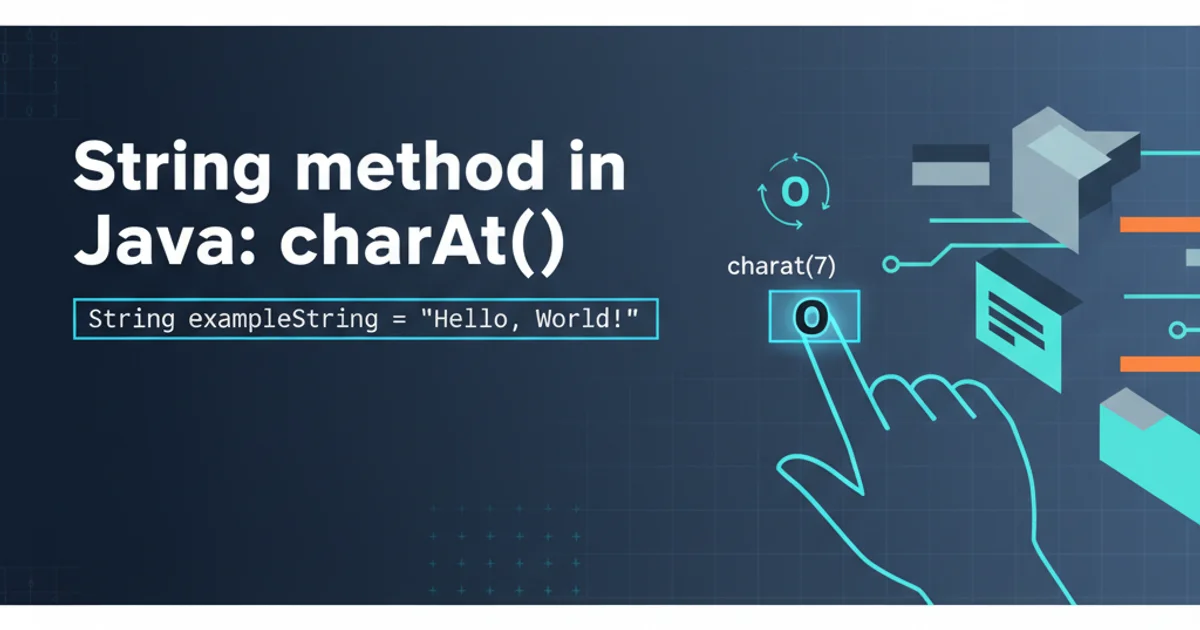String method in Java: charAt()
Categories:
Mastering Java's charAt() Method: Extracting Characters from Strings

Explore the charAt() method in Java, a fundamental tool for accessing individual characters within a string. Learn its syntax, usage, and common pitfalls.
In Java, strings are immutable sequences of characters. Often, you'll need to access or manipulate individual characters within a string. The charAt() method provides a straightforward way to retrieve a character at a specific position (index) in a string. Understanding this method is crucial for various string operations, from validation to parsing.
What is charAt()?
The charAt() method is a member of the String class in Java. It returns the character at the specified index within the string. The index is a zero-based integer, meaning the first character is at index 0, the second at index 1, and so on. The last character is at string.length() - 1.
public char charAt(int index)
Syntax of the charAt() method
Parameters
index: An integer representing the position of the character to be returned. This value must be between 0 andlength() - 1(inclusive).
Return Value
- Returns a
chardata type representing the character at the specified index.
How to Use charAt()
Using charAt() is simple. You call the method on a String object and pass the desired index as an argument. Let's look at a basic example.
public class CharAtExample {
public static void main(String[] args) {
String greeting = "Hello Java!";
// Get the character at index 0
char firstChar = greeting.charAt(0);
System.out.println("Character at index 0: " + firstChar); // Output: H
// Get the character at index 6
char sixthChar = greeting.charAt(6);
System.out.println("Character at index 6: " + sixthChar); // Output: J
// Get the last character
char lastChar = greeting.charAt(greeting.length() - 1);
System.out.println("Last character: " + lastChar); // Output: !
}
}
Basic usage of charAt() to retrieve characters
Handling IndexOutOfBoundsException
A common error when using charAt() is providing an invalid index. If the index is less than 0 or greater than or equal to the length of the string, Java will throw an IndexOutOfBoundsException. It's crucial to validate the index before calling charAt() to prevent runtime errors.
flowchart TD
A[Start] --> B{Is index valid? (0 <= index < length)};
B -- Yes --> C[Return character at index];
B -- No --> D[Throw IndexOutOfBoundsException];
C --> E[End];
D --> E[End];Flowchart illustrating charAt() index validation
public class CharAtErrorExample {
public static void main(String[] args) {
String text = "Java";
try {
// This will throw an IndexOutOfBoundsException
char invalidChar = text.charAt(4);
System.out.println("This line will not be executed: " + invalidChar);
} catch (IndexOutOfBoundsException e) {
System.err.println("Error: Invalid index provided! " + e.getMessage());
}
// Correct way to access characters safely
int safeIndex = 2;
if (safeIndex >= 0 && safeIndex < text.length()) {
char safeChar = text.charAt(safeIndex);
System.out.println("Character at safe index " + safeIndex + ": " + safeChar); // Output: v
} else {
System.out.println("Index " + safeIndex + " is out of bounds.");
}
}
}
Example demonstrating IndexOutOfBoundsException and safe access
charAt() is within the valid range [0, string.length() - 1] to avoid IndexOutOfBoundsException.Common Use Cases for charAt()
The charAt() method is fundamental and has numerous applications in string manipulation.
1. Iterating through a String
You can use charAt() within a loop to process each character of a string individually.
2. Character Validation
Check if a character at a specific position meets certain criteria (e.g., is it a digit, a letter, or a special character).
3. String Reversal (Manual)
While there are more efficient ways, charAt() can be used to manually reverse a string by iterating from the end to the beginning.
4. Parsing and Extracting Data
When dealing with fixed-format strings, charAt() can help extract specific characters or segments.
public class CharAtUseCases {
public static void main(String[] args) {
String sentence = "Programming is fun!";
// Use Case 1: Iterating through a String
System.out.println("\nIterating through string:");
for (int i = 0; i < sentence.length(); i++) {
System.out.print(sentence.charAt(i) + " ");
}
System.out.println();
// Use Case 2: Character Validation (checking for vowels)
System.out.println("\nChecking for vowels:");
char charToCheck = sentence.charAt(1);
if ("AEIOUaeiou".indexOf(charToCheck) != -1) {
System.out.println("The character '" + charToCheck + "' is a vowel.");
} else {
System.out.println("The character '" + charToCheck + "' is not a vowel.");
}
// Use Case 3: Simple String Reversal
System.out.println("\nReversing a string:");
String original = "hello";
StringBuilder reversed = new StringBuilder();
for (int i = original.length() - 1; i >= 0; i--) {
reversed.append(original.charAt(i));
}
System.out.println("Original: " + original + ", Reversed: " + reversed.toString());
}
}
Examples of charAt() in various use cases